Remote Team Management: 10 Proven Tips for Long-Term Success
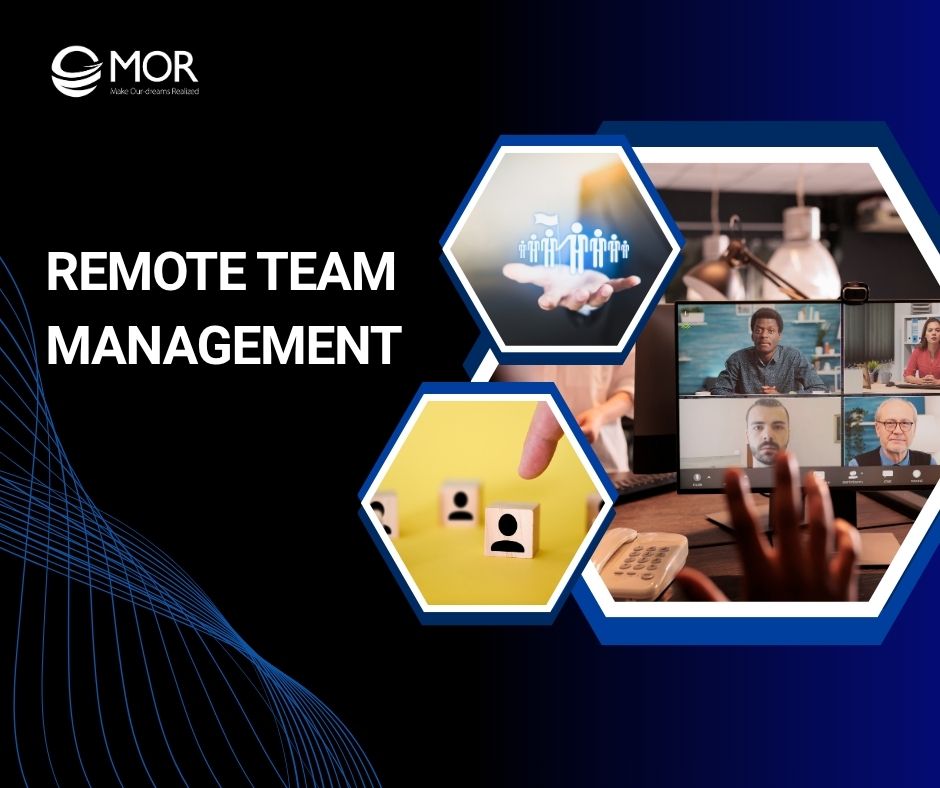
Keeping distributed teams aligned isn’t easy. Time zones, tool overload, and unclear boundaries can quietly drain productivity. Remote team management takes more than check-ins and task boards, it needs the right structure, mindset, and systems. This MOR Software’s guide will show you how to manage remote teams with proven strategies, real-world tools, and scalable support built for long-term success.
What Is Remote Team Management?
Remote team management means leading and supporting employees who work outside a traditional office, often from different cities, time zones, or even continents. It involves more than just assigning tasks or holding Zoom calls.
Managers must build structure, maintain trust, and keep everyone aligned without relying on face-to-face interaction. A Gallup workplace survey from May 2024 found that 93% of employees in remote‑capable roles want at least some remote work, with six in ten preferring a hybrid setup.

That includes everything from setting clear goals and streamlining communication to choosing the right tools and fostering team culture from afar. When done well, it empowers people to do great work, wherever they are.
The goal isn’t to control every move. It’s to give your team the support, structure, and autonomy they need to succeed.
>>> READ MORE: Salesforce Integration: The Ultimate Guide for Business Success
Common Remote Team Management Challenges
Leaders working with distributed teams often run into the same roadblocks, issues that quietly slow things down, frustrate team members, or make day-to-day operations harder than they should be. These are some of the most frequent challenges managers face when managing remote teams across locations and time zones.
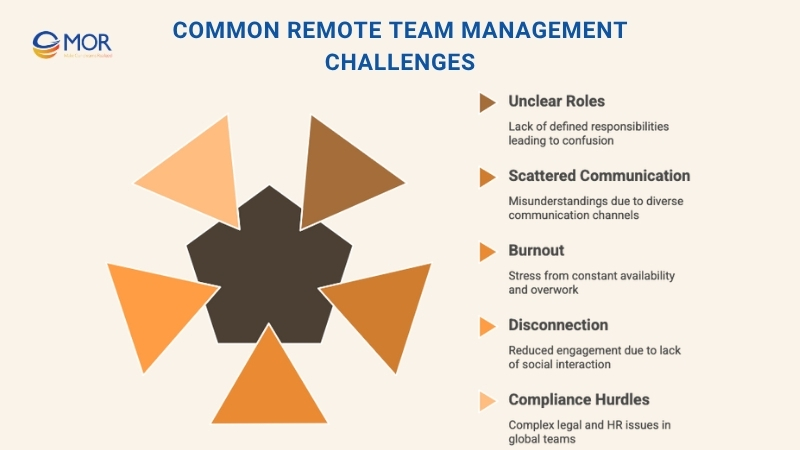
Unclear Roles And Boundaries
Without a shared physical office, setting clear expectations is tougher than it sounds. Each person has their own work rhythm, and it’s easy for priorities to drift when no one's on the same schedule. Team members may stretch their work hours without realizing it, unsure when to log off or how much is ‘enough.’
If your remote team management system doesn’t outline working hours, communication windows, and core responsibilities, the lines between work and personal life start to blur fast.
This is one of the most overlooked problems in how to manage remote teams effectively. Teams where each member receives more than 150 Slack messages daily show a markedly higher risk of burnout and confusion around priorities.
Scattered Communication
In-person interactions catch a lot of small misunderstandings before they grow into big issues. Without that face time, things slip. Messages get lost in Slack threads, emails go unread, and replies might come hours apart depending on the time zone.
That’s the everyday reality of working with remote teams. When people miss updates or feedback, productivity suffers, and small delays pile up.
It’s not just about tools, it’s about using them well, consistently, and with intent.
Burnout From Always-On Culture
When home turns into the office, the pressure to stay ‘available’ doesn’t switch off. Constant notifications, after-hours emails, and late-night video calls creep in. Over time, this always-on mentality eats away at morale and mental health. People stop taking breaks, work longer than needed, and struggle to recharge.
Buffer’s 2024 State of Remote Work report shows that 48% of remote employees work outside scheduled hours and 44% log more hours than the year before. Meanwhile, Gallup finds that fully remote staff report higher daily stress than on‑site peers, 45% versus 39%.
Burnout doesn’t just hurt individuals, it chips away at team performance and retention.
Disconnection And Isolation
Remote work has its perks, but social interaction isn’t one of them. There’s no shared coffee machine or hallway banter. That might sound minor, but it’s those small moments that build connection. Without them, people start to feel detached from the team. Engagement dips, collaboration weakens, and workplace culture takes a hit.
SHRM data cited by executives shows that 73% believe remote staff feel isolated. And a ResumeBuilder survey found 25% of remote workers saying their social skills have declined.
Managing remotely means you need to be intentional about creating space for human connection.
Compliance, Payroll, And Global HR Hurdles
When your team spans countries, HR gets complicated, fast. Tax laws, benefits, and employment classifications vary by region, and mistakes can be costly. Whether you’re hiring contractors in Europe or full-time staff in Asia, staying compliant is a moving target.
Anyone managing a remote team at scale knows this isn’t a one-size-fits-all issue. You need localized support, accurate systems, and constant updates to stay ahead.
>>> Contact us now for HRMS software solutions!
10 Remote Team Management Best Practices Every Manager Should Know
To lead a remote team that performs well over time, you need more than basic check-ins and productivity tools. These best practices will help you build trust, keep goals clear, and run a team that actually works.
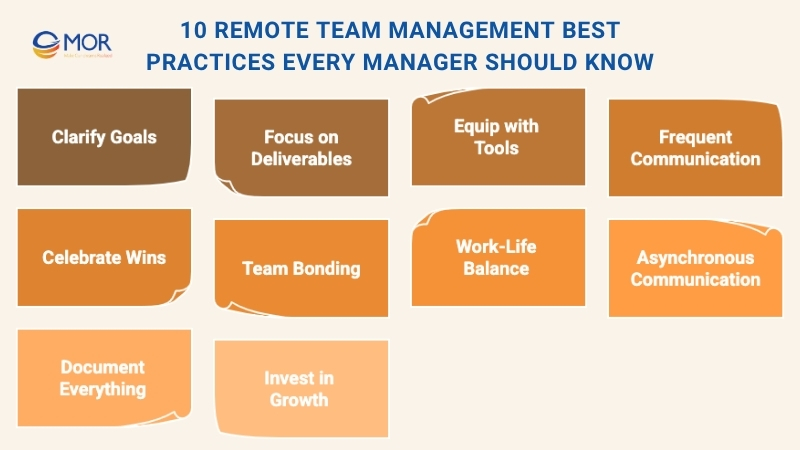
Clarify Goals And Responsibilities
It’s hard to hit a target if no one knows where it is. That’s why clear expectations matter so much in remote team management. Yet many employees still feel unsure about what’s expected of them. When roles are fuzzy, performance slips. People stall out, redo work, or head in the wrong direction entirely.
The fix? Keep things flexible, but build structure. Start by breaking down every role, what success looks like, how progress is tracked, and where each person fits into the company mission.
If you’re wondering how to manage a remote team with clarity, a shared roadmap helps. Build project workflows that assign specific tasks, deadlines, and touchpoints. This gives your team a concrete view of who’s doing what, and when.
A good place to start is SMART goals:
- Specific: Spell it out, vague goals go nowhere.
- Measurable: Make progress visible.
- Achievable: Keep goals realistic and motivating.
- Relevant: Tie it to team or business priorities.
- Time-bound: Deadlines keep things moving.
When everyone understands the what, why, and when, accountability becomes part of the culture. And that’s what makes leading remote teams more sustainable in the long run.
Focus On Deliverables, Not Hours
Watching the clock doesn’t build trust, it breaks it. A Harvard Business Review study found that 20% of remote workers feel like their manager is constantly checking up on them. One in three say their boss doubts their skills. That kind of pressure doesn’t lead to better work. It leads to burnout, resentment, and silence.
Effective remote team management isn’t about tracking hours. It’s about tracking outcomes. The real question isn’t “Are they online?” It’s “Are they delivering what matters?”
When managing remote teams, focus on clear deliverables tied to business goals. Let your team own the path, as long as they hit the destination. Regular check-ins, quarterly progress reviews, and defined KPIs help keep people aligned without breathing down their necks.
If you're trying to figure out how to manage remote teams without falling into micromanagement, shift your lens. Set success metrics your team can influence directly. Then step back. Let them take control of the ‘how’ while you guide the ‘what’ and ‘why.’
That’s how trust and performance grow together, on purpose, not by accident.
Equip The Team With The Right Tools
No team works well without the right setup, especially when they’re spread across cities, countries, or time zones. Strong remote team management depends on the tools your team uses every day. That includes platforms for task tracking, file sharing, security, and real-time collaboration.
But it’s not just about handing out apps. Check in regularly. Ask what’s working, what’s clunky, and where gaps still exist. The best tech stack should feel connected, not cobbled together. Choose tools that talk to each other to avoid jumping between tabs or losing updates.
Some go-to picks for managing remote teams best practices:
- Asana: For organizing projects and tracking tasks
- Slack: Quick team messaging without the email clutter
- Google Drive: Share and store docs securely in the cloud
- Zoom: Host team meetings, workshops, and 1:1s
- GitHub: Ideal for developers working across codebases
The more seamless the tools, the smoother the workflows. With the right stack in place, manage hybrid work teams with less friction and more flow.
Keep Communication Frequent And Clear
In remote team management, silence isn’t golden, it’s risky. Without casual chats or hallway catchups, it’s easy for people to fall out of sync. That’s why overcommunicating is often better than undercommunicating when managing a remote team.
Start with regular check-ins, but don’t treat them like status reports. Use them to build trust. Each conversation should touch on workload, blockers, goals, and growth. A shared agenda helps steer the talk while leaving space for open dialogue. Keep it structured, but personal.
For new hires, step it up. Weekly or biweekly check-ins during their first 90 days help build confidence and reduce guesswork. It shows you’re present without hovering. And it sets the tone for future interactions.
Good communication isn’t just about frequency, it’s about clarity, context, and care. That’s what separates managers from leaders when it comes to leading remote teams.
Celebrate Wins, Big Or Small
Recognition goes a long way in remote team management. When your team works from different places, it's easy for great work to fly under the radar. That’s why celebrating achievements, big or small, matters more than ever. Public shout-outs during team calls, private thank-you notes, or monthly awards all help reinforce good work and boost morale.
Want to take it a step further? Try peer recognition programs. Let teammates highlight each other’s wins. It builds trust, encourages gratitude, and fosters a positive environment, even across time zones.
Whether it's a client milestone or a personal best, recognizing results keeps motivation high and culture strong. If you're figuring out how to manage remote teams, start by making appreciation a habit, not an afterthought.
Make Time For Team Bonding
Remote work can get lonely, fast. Without breakroom banter or lunch catchups, employees may start to feel disconnected. That’s where team-building comes in. And no, you don’t need to fly everyone in.
Virtual hangouts work just fine. With a bit of creativity, you can run online activities that get people laughing, talking, and collaborating in a more relaxed setting. From trivia nights to wellness sessions, the options are endless.
A few low-effort ideas to spark connection:
- Online karaoke
- Virtual book clubs
- Escape rooms or scavenger hunts
- Mindfulness or fitness sessions
Regular bonding activities make managing remote teams easier because they build relationships that stick. And better relationships lead to better results, even when your team is spread across the globe.
Set The Tone For Work-Life Balance
Remote work makes it easy for hours to bleed into evenings, weekends, and everything in between. As a manager, your actions set the pace. Healthy remote team management starts with modeling healthy boundaries.
Let your team know it’s okay to log off. Encourage breaks. Share wellness resources like meditation apps or fitness stipends. Offer flexible work hours so people can structure their day based on energy levels, time zones, or family needs.
It’s not just about avoiding burnout. A team that feels respected is more likely to stay engaged and productive. That’s a key lesson in how to manage remote teams for the long haul.
Lean Into Asynchronous Communication
Not everything needs an instant reply. In fact, forcing real-time communication across time zones slows teams down. That’s where asynchronous tools come in.
Remote team management gets smoother when people can respond on their own schedule. Emails, Loom videos, shared docs, or project boards let your team absorb information, think it through, and reply with more clarity. It reduces pressure, cuts meetings, and keeps work moving without unnecessary friction.
If you’re managing remotely, teach your team how to use async tools well. Set clear expectations around response times and when synchronous communication is actually necessary. This approach respects time, encourages deep work, and reduces miscommunication.
Document Everything
When your team isn’t in the same room, clear documentation becomes your safety net. Good remote team management relies on written workflows, not hallway conversations. Without a central hub of truth, it’s easy for key info to get lost, or stuck in someone’s head.
Use tools like Notion, Confluence, or shared drives to store everything from onboarding guides to project checklists. These platforms make it easy to find what you need, fast. Encourage team members to update docs regularly, especially after process changes or project retros.
If you're wondering how to manage remote teams without repeating instructions or answering the same questions twice, documentation is your best friend. It saves time, smooths handoffs, and helps new hires ramp up quickly.
Invest In Career Growth
Growth shouldn’t stall just because your team is remote. One of the most underrated parts of remote team management is professional development. When people can see a clear path forward, they’re more likely to stick around and stay motivated.
Start by mapping career paths for each role. Schedule regular 1:1s to talk about goals, learning interests, and advancement opportunities. Offer virtual courses, certifications, and tools for upskilling. Don’t stop there, build mentorship programs and cross-training so team members can explore new directions within the company.
If you're managing a remote team, this kind of support isn’t optional, it’s part of the culture. Career growth builds loyalty. And loyal teams do their best work.
>>> READ MORE: Top 10 Vietnam HR Outsourcing Companies [Ranked – 2025 Edition]
What Makes A Great Remote Team Manager
Being a remote manager means more than assigning tasks and tracking deadlines. It takes a specific set of skills to lead with clarity, empathy, and consistency from a distance.
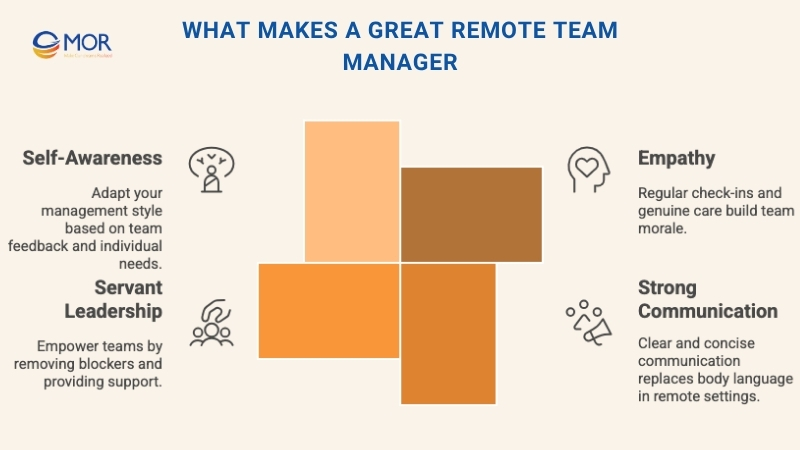
Empathy
Being a strong leader in remote team management means more than just tracking tasks. Great managers lead with empathy. Without face-to-face interaction, it’s easy to miss when someone’s struggling. That’s why thoughtful check-ins, genuine care, and an understanding of each person’s situation go a long way.
The goal isn’t just productivity, it’s well-being. That’s what keeps teams engaged and committed over time.
Strong Communication
You can’t rely on body language or tone in remote work, so what you say, and how you say it, matters more. Great managers keep communication clear, structured, and easy to follow. They write things down, repeat key decisions, and use the right mix of formats: calls, messages, docs, and videos.
They also don’t overwhelm the team with calls. Balance is key when leading remote teams with focus and respect for everyone’s time.
Servant Leadership
Micromanagement doesn’t work remotely. The best leaders serve their team first. They give people room to own their work while stepping in with tools, feedback, and help when needed. They fix blockers instead of creating them.
If you’re asking how to manage a remote team well, start by removing friction, not adding more of it.
Self-Awareness
Every team is different. The best remote managers know that their approach isn’t one-size-fits-all. They understand their own strengths and blind spots, welcome feedback, and adjust their leadership style based on what the team needs.
This kind of self-awareness builds trust. And trust is the foundation of every successful remote team.
Top Tools For Remote Team Management
The right tools make remote team management smoother, faster, and less stressful. These platforms help your team stay connected, aligned, and productive, no matter where they work.
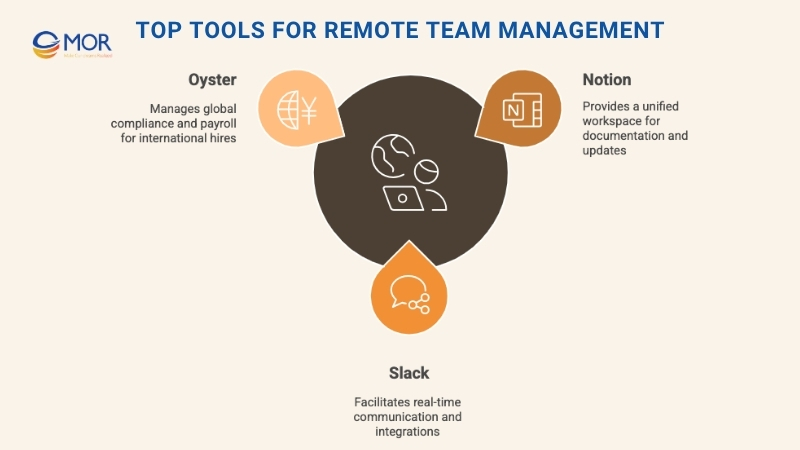
Notion
Notion keeps your team’s brain in one place. From SOPs and knowledge bases to shared boards and project notes, everything lives in one workspace. With real-time updates and collaborative editing, it’s easy to document workflows and reduce unnecessary meetings.
It also encourages asynchronous work, which makes things smoother when you’re trying to manage hybrid work teams without constant check-ins.
Slack
Slack makes conversations fast, direct, and focused. Instead of chasing down updates or waiting on email replies, teams can jump into dedicated channels and stay in sync. It’s especially helpful when managing remote teams, since it keeps communication fluid and organized.
Better yet, Slack works well with other tools like Notion and Google Drive, so information flows without disruption. Messaging, video calls, and integrations in one place. It’s a must-have for any remote setup.
Oyster
Scaling a global team sounds exciting, until compliance, payroll, and tax laws get in the way. That’s where Oyster comes in. It simplifies remote team management for companies hiring across borders. Oyster handles onboarding, benefits, and labor law compliance so you don’t have to set up a legal entity in every country.
With Oyster, you can hire talent in over 180 countries while staying compliant with local rules. For companies that are still figuring out how to manage remote teams, this kind of platform removes guesswork and legal headaches.
How MOR Software Helps You Manage Remote Teams?
At MOR Software, remote team management isn’t just a service. It’s our core strength. We help you build and scale offshore teams that feel fully integrated with your own, without the overhead.
Our approach starts with transparent onboarding and flexible team setup. You choose the roles, we help you fill them fast. Once the team is in place, we apply Agile or Scrum to keep workflows clear, deliverables on track, and priorities aligned.
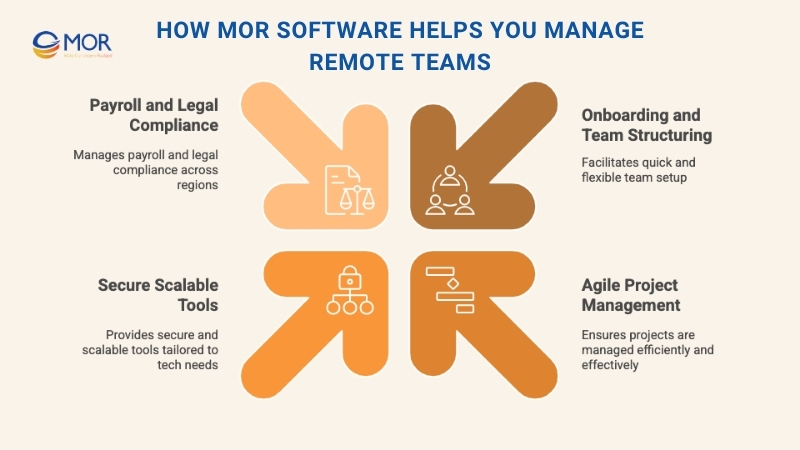
Security and collaboration? We’ve got that covered too. Our engineers use secure, scalable toolchains tailored to your tech stack, from Git to Jira to Slack. Plus, every project comes with built-in QA, testing, and cloud-ready architecture for easy scaling.
Need help navigating payroll and compliance? We handle local and global regulations so you don’t have to. Whether your team’s in Vietnam, Japan, or across multiple regions, we make sure your operations stay compliant and smooth.
From kickoff to delivery and beyond, we help you run remote teams that actually work. Ready to scale smarter? Contact us today.
Conclusion
Remote team management works best when there's trust, structure, and clear communication, no matter where your team is located. When managers stay focused on outcomes, support career growth, and lead with empathy, remote teams can consistently deliver great results. With dedicated offshore IT outsourcing teams, secure tools, and scalable support, we give you everything you need to lead remote teams with confidence. Contact us to start building your high-performing team.
MOR SOFTWARE
Frequently Asked Questions (FAQs)
What is remote team management?
Remote team management refers to overseeing a group of employees working from different locations. It involves communication, task coordination, performance tracking, and maintaining team engagement without physical office space.
How do you keep remote teams motivated?
Regular recognition, clear goals, open communication, and virtual team-building activities help keep remote employees motivated and connected to their work.
What tools are essential for managing remote teams?
Popular tools include Slack or Microsoft Teams for communication, Asana or Trello for task tracking, Zoom or Google Meet for meetings, and Notion or Confluence for documentation.
How can managers track performance without micromanaging?
Set clear deliverables and deadlines, use project management tools to monitor progress, and hold regular check-ins focused on outcomes, not hours worked.
What are common mistakes in remote team management?
Micromanaging, poor communication, unclear expectations, ignoring time zone differences, and lack of feedback are all common pitfalls when managing remote teams.
Rate this article
0
over 5.0 based on 0 reviews
Your rating on this news:
Name
*Email
*Write your comment
*Send your comment
1